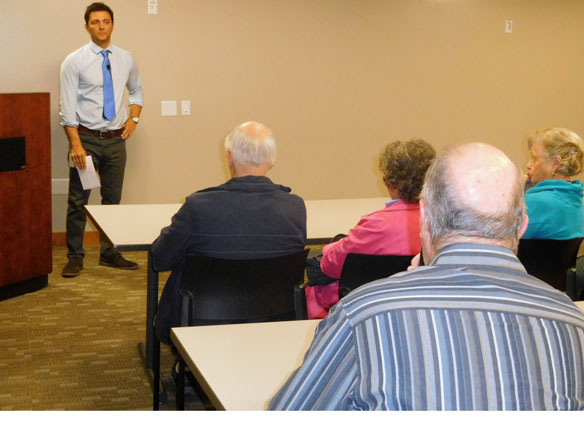Judging from a Feb. 9 town hall meeting hosted by newly elected City Councilman Ben Kalasho, the biggest problem facing El Cajon is a surge in the homeless population.
At a packed assembly estimated at 80 residents held at the El Cajon Police Station, a majority questioned Kalasho about what the city is now doing to address the growing numbers of unsheltered neighbors, and what more can be done.
Judging from a Feb. 9 town hall meeting hosted by newly elected City Councilman Ben Kalasho, the biggest problem facing El Cajon is a surge in the homeless population.
At a packed assembly estimated at 80 residents held at the El Cajon Police Station, a majority questioned Kalasho about what the city is now doing to address the growing numbers of unsheltered neighbors, and what more can be done.
The operations at Gillespie Field were also a hot topic among a sizable group of residents, both those against increased flights, and those supporting the airfield.
“It’s become an epidemic,” said one resident, who didn’t give his name on the increased homeless people near his home. “When I drive through there every day and you see (all the refuse and shopping carts) you just want to throw up.”
Others said the homeless population has been steadily increasing in recent years, and some of it can be blamed on surrounding cities. One resident, N. Powell, said last year, in advance of the All-Star Game, homeless folks in downtown San Diego were effectively pushed east, and that effort is continuing.
Asked whether El Cajon had any plan dealing with the influx of more homeless people, Kalasho said, “No, not really.’
Another woman resident charged that the city is making it easier for homeless to survive, and compared El Cajon to other cities where homelessness isn’t so apparent.
“You never see a homeless person in Carlsbad….but El Cajon is known on TV as the anus of America. It’s just gotten really, really bad, and out of hand.”
Kalasho sympathized with residents, but said he frankly had no ready solutions. Many homeless are suffering from mental and physical problems, while others are daily drug users and alcoholics, and have no intention or incapable of changing, he said.
Then there’s a new segment of younger, more aggressive transients, who threaten those approaching them, by whipping out their cell phones, and saying, ‘What do you want from me? My lawyer’s on speed dial,’” Kalasho said.
Yet a small number of homeless that Kalasho estimated at 20 to 30 percent, are receptive to change, and ready, willing and able to work. These are the ones that a comprehensive job program would target, he said.
Kalasho his program would get people into transitional housing and a job, but also included banning aggressive pan handling, and taking away their shopping carts.
Kalasho said his colleagues on the city council rejected his proposal. “It was nixed but in no way am I giving up on it,” he said.
Another part of his solution involves getting liquor stores to voluntarily stop selling booze to drunken people. Kalasho noted that as a Chaldean, a Christian Iraqi, he had some sway in obtaining buy-in from the shopkeepers.
“It’s going to take someone like me, one of their own, to tell them ‘You’re being defined by this,’” Kalasho said. “You can redefine yourself.”
One woman who was affiliated with a local church said she wanted to partner with the city to do outreach to the homeless, but Kalasho said his experience in working with churches on the issue hasn’t been all that productive.
Many times church homeless programs have the best of intentions but when they are feeding people who have been on the streets for a decade, it’s clearly not working, Kalasho said.
“I don’t believe in enabling; I believe in empowering,” he said. “I’m more than willing to partner (with churches) but we have to have a meeting of minds.”
A sizable number of residents were also interested in Gillespie Field, with some complaining about the noise from increased flights. Others, mostly pilots and former pilots, said the airport on the northern edge of the city generates lots of tax revenue and jobs, and deserves the city’s full support.
Leslie Day said as the owner of a hanger at the airport, she pays more than $5,000 annually in property taxes on the structure, with some of that money going to El Cajon and local school districts. She also uses a slew of other services from local vendors. “And I’m one of over 800 pilots….We pay a lot of money into the system,” she said.
Rob Dennis, an aircraft parts business owner, said there’s less air traffic at Gillespie Field today than there was 20 years ago.
Tom Hannawa, president of American Aviation Academy, one of five flight schools at Gillespie, said his school generates “quite a bit of revenue from foreign nationals.”
Several residents said the surge of student flights by the schools is causing more noise. One asked about a purported agreement between a major flight school, Emory-Riddle, and the county to add even more students.
Yet several pilots said there was no agreement. Hannawa said if true, the alleged agreement would “put us on the map.”
When one resident complained about pilots not adhering to flight paths and flying at lower elevations, thus causing more noise, some pilots said the paths are only recommendations from the FAA, are not required.
Kalasho, the owner of a car wash and a day trader, readily admitted he didn’t have answers to all the residents’ questions but assured them he’d get back to anyone who provided their contact information. He said the town hall was being held to get to know residents better, and to determine how he could do his job better.
“I want to be accessible to each of you, and want to go to work for you,” he said. He said he can be reached via his website and email, Facebook, Twitter, or by phone.
Kalasho said he’d probably do another town hall next month.













